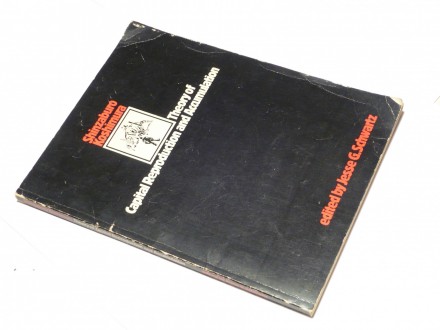Theory of Capital Reproduction and Accumulation
| Cena: |
| Želi ovaj predmet: | 6 |
| Stanje: | Polovan bez oštećenja |
| Garancija: | Ne |
| Isporuka: | Pošta Post Express Lično preuzimanje |
| Plaćanje: | Tekući račun (pre slanja) Lično |
| Grad: |
Beograd-Zvezdara, Beograd-Zvezdara |
ISBN: 0919946003
Godina izdanja: 1975
Jezik: Engleski
Autor: Strani
Shinzaburo Koshimura - Theory of Capital Reproduction and Accumulation
DPG Pub. Co., 1975
161 str.
meki povez
stanje: dobro, pečat na predlistu.
Edited by Jesse G. Schwartz. Translated by Toshihiro Ataka.
‘In the analysis of economic forms, neither microscopes nor chemical reagents are of use. The force of abstraction must replace both.’
Thus does Koshimura quote Marx in the introduction to his book. But he gives no warning that the process of abstraction, of simplification, of a movement away from the material and historical world in order to concentrate attention on the central factors, is only one side of a two-sided process for making sense of the social world. Marx spends a lot of time in Capital relating his abstract world back to the real events of history and the real motions of the world. This is especially essential to Marx because he sees all social phenomena as being indissolvably part of the material world which men and women shape by their collective efforts. Economic systems built in academic thin air may be logically faultless, but tell us little or nothing about the real world.
Marx could show theoretically that the concentration and centralisation of capital into relatively fewer and fewer, larger and larger units was possible, but only the concrete realities of technology and economies of scale on the one hand, and of crises which bankrupt weak capitals on the other, make the theoretical possibility an historical fact. Likewise with Marx’s contention that there existed a tendency for the rate of profit to fall. Only the positioning of the theory within the complex web of the real world, a world within which national capitals fight for resources and shares of world surplus value, transforms it from an intriguing chimera of doctrinal history into a powerful tool of analysis.
Unfortunately Koshimura’s book, written nearly 20 years ago in Japanese and appearing in English for the first time, studiously avoids any such attempts to locate Marxist theory in the real world. It is the work of an academic Marxist, a mathematical scholastic economist. As such it will be incomprehensible for the most part to readers who do not possess a working knowledge of advanced maths. Basically it represents an early example of an increasing number of attempts to make Marxist economics ‘respectable’ to the world of universities and radical students of bourgeois economics. He sees the main need to give Marxist economics a greater ‘formal coherence’ because, to Koshimura’s ‘greatest regret (it) lags behind modern bourgeois economics’ in this respect. Only in this way can we establish ‘a science of Political Economy’. Not surprisingly therefore the book’s climax is to develop a formal picture of price and profit determination in a system of monopolies. Monopoly dealt with in this formal way is the nearest point the book gets to in reflecting the modern world. Marx is, in the process, reduced to the status of an alternative theory of how prices are formed, despite passing references to his prime concern with the social relationships which underly the functioning of the economic system.
Along the way Koshimura’s total lack of reference to the world about us produces some strange omissions. For example, in chapter seven, on the tendency for the rate of profit to fall, there is no consideration of counter-acting tendencies, either their status within Marx’s model or their relevance today. Nor does he refer to the Luxemburg-Bukharin exchange concerning the overproduction of consumer goods when he relates the rate of profit to the structure of capital reproduction. This is a pity because within the limits he sets upon himself Koshimura writes cogently and coherently (with the notable exception of his chapter five formulation for a uniform rate of profit which even he seems to be aware of).
Marxist economics is very much in need of a work which pulls together a rigorous presentation of analysis with the processes of the material world; particularly at a time when it is fashionable in New Left circles to abandon materialism under the guise of rejecting ‘empiricism’ and produce yet another bastard called ‘revisionism’. This is not that work, nor anything like it.
John Ure
Nonfiction, Mathematical models, Marxian economics, Capital
Plaćanje pouzećem i postnetom za sada nisu opcija.
Lično preuzimanje je isključivo na Konjarniku uz prethodni dogovor.
Hvala na razumevanju.
Predmet: 51960901







